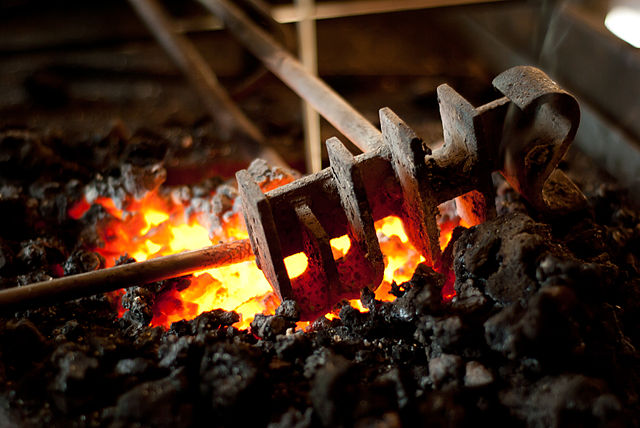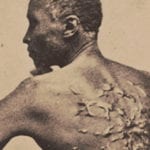 Mysteries
Mysteries  Mysteries
Mysteries  Music
Music 10 Musicians Who Changed How Everyone Plays Their Instruments
 Humans
Humans 10 Inventors Who Died Awful Deaths in Their Own Creations
 Animals
Animals 10 Ways Animals Use Deception to Survive
 Movies and TV
Movies and TV 10 Misdirections Directors Used to Manipulate Actors
 Politics
Politics The 10 Boldest Coup Attempts of the 21st Century
 Weird Stuff
Weird Stuff 10 Things That Would Have Killed You in the Old West
 Books
Books 10 Pen Names More Famous Than Their Authors
 Creepy
Creepy 10 Unnerving Legends from Around the World
 Movies and TV
Movies and TV 10 Amazing Lead Actor Ideas for Superhero Movies
 Mysteries
Mysteries 10 Bizarre, Little-Known Phenomena
 Music
Music 10 Musicians Who Changed How Everyone Plays Their Instruments
 Humans
Humans 10 Inventors Who Died Awful Deaths in Their Own Creations
Who's Behind Listverse?

Jamie Frater
Head Editor
Jamie founded Listverse due to an insatiable desire to share fascinating, obscure, and bizarre facts. He has been a guest speaker on numerous national radio and television stations and is a five time published author.
More About Us Animals
Animals 10 Ways Animals Use Deception to Survive
 Movies and TV
Movies and TV 10 Misdirections Directors Used to Manipulate Actors
 Politics
Politics The 10 Boldest Coup Attempts of the 21st Century
 Weird Stuff
Weird Stuff 10 Things That Would Have Killed You in the Old West
 Books
Books 10 Pen Names More Famous Than Their Authors
 Creepy
Creepy 10 Unnerving Legends from Around the World
 Movies and TV
Movies and TV 10 Amazing Lead Actor Ideas for Superhero Movies
10 Colonial Punishments We Thankfully Ended
Crime is inevitable, even in a world run by Pilgrims and Puritans. Where there is crime, there is punishment. Starting back in 1608 with our first documented execution, America established a penal system based on Old English ideals. This made way for some pretty not-so-great methods of punishment when it came to the New World.
During our country’s birth, incarceration was an alien concept. We may have over two million people in prison currently, but our founders did not see imprisonment as beneficial. Swift punishments meant you paid a fine, were physically brutalized, publicly shamed, or executed.
Here are 10 punishments that thankfully ended in order from bad to “oh dear God, why?”
Related: 10 Startling Facts About Crime And Punishment In English History
10 Stocks
The stocks are probably the most recognizable colonial time punishment. Also known as the pillory, the stocks held your hands and head in a wooden vice so that you could not move, and you were placed in town for all to see. People were encouraged to throw trash, stones, and other things that shouldn’t be held, let alone thrown. The wooden pillory was actually an altered version of the English bilboes, which were iron rods with shackles meant to keep the victim’s arms up while being chained to their feet. However, metal was expensive, so they moved to wooden stocks instead.
In comparison to many of the other possibilities, being put in the stocks wasn’t so bad. However, what seemed to be common was that during the colonial period, punishments were thrown together like a painful, forced repentant salad. The stocks were often paired with branding, ear cropping, or whipping. In some rare instances, the stocks could be fatal due to items being missiled at the prisoner. [1]
9 Flogging
Flogging, or whipping, was the prom queen of penance. There was a post in town for the sole purpose of whipping criminals publicly. Besides colonists just not having much else to do in their free time, public penance was popular due to the idea that people were unmalleable. With most laws being religiously centered, whipping was also a popular choice because it was believed to awaken the spirit and remind the soul that they were to serve God. This was also justification for whipping disobedient children.
Flogging could be done with a variety of items, including whips, sticks, and a multiple rope tool called a cat-o-nine-tails. Whipping was for lower-class citizens and slaves, and because they made up the bulk of the population, it could be seen frequently. As with the stocks, death was extremely rare and not the end goal of a flogging. In most cases, the scars from a whipping could be hidden, so moving on wasn’t impossible. With the next punishment, that was not the case.[2]
8 Branding

In The Scarlet Letter, Hester Prynne was lucky that her branding was just wearing the letter “A,” not having an A burnt into her forehead. The word “brand” has several origins, one being the Old English word for “destruction by fire,” and it worked just like it does with cattle. The metal letter is heated and pressed to the skin to make a scar. Different letters were used for different crimes. You could read it like a children’s book: “A” for adulterer, “B” for blasphemer, “D” for Drunk, “F” for forgery, and “T” for thief.
Another letter commonly branded was an “R,” which stood for runaway. Slaves were very often sentenced to physical punishments over very small indiscretions. If they tried to escape, then an “R” was branded on their foreheads. Foreheads and cheeks were popular burn sites depending on the crime. Some perpetrators could sometimes plead for mercy and get branded on the arm or hand instead. Being marked for life was not something one would relish, but a scar left behind doesn’t seem as bad as losing a whole body part. For example, an ear.[3]
7 Ear Cropping
A man in England who lived during King Henry VIII’s reign made the mistake of saying he thought the king was dead. Well, the king was alive, and saying otherwise was treason. To the pillory he went, and his ears were nailed to the stocks. After a day passed, his ears were cut off, and he was free to go. The thing about this was the ears were going to be taken no matter what, but the goal was to make the sufferer rip their own ears off trying to escape.
There was no overarching system of rules when it came to sentencing a punishment. There was no consistency in what was considered cruel versus just. Even within a sentence of ear cropping, there were variations. Sometimes the ears were hammered to the stocks, sometimes they were straight-up removed, and sometimes only pieces were removed. As with branding, losing one’s ears was not only painful but also humiliating. Hiding your earless new look was not easily done.[4]
6 Branks
Although arguably not as painful as losing an ear, the brank is something straight out of a horror movie. The mix of pain with the avert humiliation of the brank makes it one of the more egregious punishments. It was used for those who spoke out against the church, gossiped, or nagged. It was known as the “gossip bridle” or “scold’s helm.”
An iron cage was placed over the accused person’s head with a plate stuck into their mouth that held their tongue down. Sometimes the plate was adorned with spikes. Almost always, the plate was large enough to cause hours of gagging while wearing it. To make the brank even more degrading, it could be topped with a bell so everyone would know you were approaching or a leash to be walked through town.
There is not much documented on the brank being used in colonial America, not as much as there is on them being used in Europe, at least. However, there are records of its use, especially with slaves. One of the reasons the brank could be so horrible was there wasn’t a set time limit. Maybe you were in the brank for a few hours, maybe days. Branks were mostly for women, as was the next punishment.[5]
5 Ducking
The terms cucking stools and ducking stools are used interchangeably, but they are not the same thing. Cucking stools were seats that the victim was strapped to and paraded through town. Ducking stools were the same construction, only they were placed at the end of a lever that moved up and down, dunking the person strapped in underwater. The ducking stools became so popular that Maryland eventually passed a law that all counties must have a ducking stool.
Like the brank, ducking was used mostly as a recourse for women criminals. The result of the ducking stool was supposed to be a confession from the accused or an agreement to repent for their crimes. There was no set time limit for the stool nor time to be held underwater. Casualties resulted because of this. Ducking was not supposed to be fatal, but sometimes the victim would die of shock or drowning.
All these mentioned were punishments meant to scare, harm, and humiliate. Now we move to the darker side of corporal punishment. Spoiler alert: everyone dies at the end.[6]
4 Hanging
Hanging was the most common method for a sentence of death in Colonial America. It was used if someone committed a heinous crime such as murder, infanticide, rape, or other sex crimes. A seventeen-year-old boy from Plymouth was found guilty of several counts of buggery (bestiality, in this case), including a horse, a cow, two goats, five sheep, and a turkey. I’m not sure how these animals were calculated so succinctly, but he was hung to death, and the animals were buried alive as the good Lord intended.
Hanging could be sentenced for men and women alike, and sometimes even children. During the Golden Age of Piracy (1690-1730), hanging was the main form of execution for those convicted. It is estimated that 10% of the pirate population in the Caribbean during this time met the gallows in America.
Generally, the hangman was not a professional but just a law figure within the colony or a judge. This less-than-ideal experience almost certainly led to more botched hangings than successful ones. If the rope was too short, the criminal’s neck wouldn’t break, so they would strangle to death. If it was too long, they might get beheaded. Which leads us to beheadings.[7]
3 Beheading
“Off with their heads!” is one of the most known lines in literature or from a Disney film, depending on your taste. During Colonial America, it was shameful when your severed head was posted publicly. In contrast, for most of history, beheading was reserved for the upper class and seen as honorable in Europe. If it was done correctly, it was a swift and quick death.
However, the neck is not as fragile as one may think. Just like hangings, there wasn’t anyone trained in the art of beheading. This increased the likelihood of needing more than one attempt at decapitation, creating a need for multiple swings or repeated use of the guillotine. In some instances, the blade hit the head, not the neck.
Despite the possibility of a botched beheading, it was still preferred in England and the colonies to the alternatives. Anne Boleyn, for instance, was charged with treason and adultery. King Henry VIII could have chosen her to be burned at the stake or decapitated. For the victim, it seems like an easy choice.[8]
2 Burning at the Stake
Fire is argued as the thing that separates man from animals. The control of fire has been used for good and for horrifically bad. There is a misconception that Colonial America came to its roots of burning at the stake during the Salem Witch Trials. The problem is Salem hung their witches. This does not negate the fact that burning at the stake was a not-so-rare method of capital punishment and a brutal one at that. From the ancient world, it moved into Europe and became the symbol of anti-religious punishment. Heretics, blasphemers, and rebels were burned.
Like so many other laws and punishments in our country, being burned at the stake has a racist history. Most women who were burned at the stake were black. White women convicted of the same crimes were generally hanged. Homosexuals also had to fear the fire. Due to the religious foothold of the colonies, homosexuality was punished by burning. If you were lucky, you were granted some sort of mediation to your death. For instance, sometimes, the victim would be strapped with gunpowder so that it would explode once the heat got to a certain level and kill them instantly.[9]
1 Drawn and Quartered
“Hanged, drawn, and quartered” sounds like an album put out by a B-rated punk band. But no, it was a form of torturous death. The sentenced criminal would be hanged, taken down from the gallows alive, have their limbs tied to four horses, and then ripped into four parts. Another variation included being drugged to the gallows by a horse, hung til almost dead, then disemboweled publically. Afterward, the corpse would be quartered.
This form of capital punishment was not a popular one and seemed to be mandated more by English occupants than actual settlers. Because of this, treason was the number one crime that was eligible for being drawn and quartered. In England, hanged, drawn, and quartered punishment was reserved only for men who were found guilty of treason. With little documentation on how exactly this was adopted in colonial America, it’s fair to say it was the same procedure.
There were dozens of punishments that would be considered cruel and unusual by today’s standards. There are references to colonists using the breaking wheel and boiling victims in oil. Both are adopted from Old England’s torturous methods of the 1500s, and both seem almost too much for us to consider as part of our heritage. Without detailed records on them, they didn’t make the list. I think we have been through enough heartbreak anyway.
Before we harshly judge the settlers and their methods of punishment, we must remember they were living in very hard times or had just survived being starved, frozen, and constantly surrounded by death for months at a time. Racism and fear also lent to the horrific practices of our penal system.[10]








